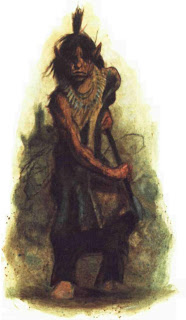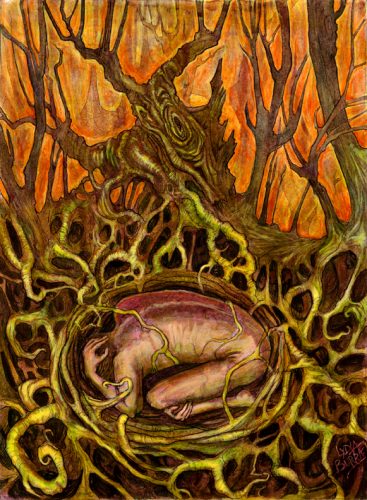 According to the Onyx Path development Blog the Changeling the Dreaming 20th Anniversary edition is nearing completion, and rumors about that the Monsters Sourcebook for Chill 3rd edition is nearing completion. Given these exciting developments it only made sense for Victor Kinzer and Simon Eichhörnchen to ask Matthew McFarland who is leading development on both of these projects to talk a little bit about these projects and he graciously agreed.
According to the Onyx Path development Blog the Changeling the Dreaming 20th Anniversary edition is nearing completion, and rumors about that the Monsters Sourcebook for Chill 3rd edition is nearing completion. Given these exciting developments it only made sense for Victor Kinzer and Simon Eichhörnchen to ask Matthew McFarland who is leading development on both of these projects to talk a little bit about these projects and he graciously agreed.
Victor: Thank you for taking the time to chat with us. For anyone who isn’t familiar, can you tell us a little bit about yourself and your history developing games?
Sure! I started writing games professionally in 1997. White Wolf Game Studio had an all-call for writers, and I sent in the first bit of a novella I was working on. That novella is thankfully lost to time, but it did get me a job writing on Giovanni Chronicles IV, and then I slowly infiltrated the rest of the World of Darkness lines and eventually got a full-time job as Dark Ages developer.
I left White Wolf in 2004, and went to grad school to become a speech-language pathologist, because while you can have steady work in the RPG industry, it was a little too unstable for me as a new dad. In 2012, my wife Michelle Lyons-McFarland and I started our own small press games company, Growling Door Games, Inc. We published two single-book story games (curse the darkness and A Tragedy in Five Acts), and then 2014 we obtained the license to publish a new edition of the classic horror RPG Chill.
Simon: What was it that attracted you to the projects you’re working on now?
Right now, I’m working on a couple of freelance projects for Onyx Path Publishing (which licenses the World of Darkness from the new owners at Paradox)[Editor’s Note, The World of Darkness is a property of White Wolf, AB a subsidiary of Paradox Entertainment Inc.], including the Beast Player’s Guide for Beast: The Primordial and the second edition of Hunter: The Vigil. Can’t talk much about Hunter; that’s Monica Valentinelli’s show, and I’m just a writer. Beast is very much my show; the game was mine pretty much from the ground up (though of course I had a really awesome team of people helping to put it all together), and I’m excited about the Player’s Guide. It’s a chance to flesh out the areas of Beast that I don’t think came through as well as we wanted in the core book, and also follow the time-honored tradition of adding new cool powers, new “splats”, and new toys for players to use.
Outside of Onyx Path, I just finished up writing a sourcebook for Chil called Monsters. It’s a bestiary book, in a way, but it’s also a look into the world of Chill and how the organization dedicated to fighting the Unknown, SAVE, approaches creatures that don’t fall into easily understandable categories (vampires, ghosts, werewolves, etc.). Monsters is the first book in a good long while that I’ve written entirely myself, and it was fun flexing those muscles again. (Monsters should be available for sale in August, by the way.)
 Victor: The Changeling the Dreaming 20th Anniversary is the first new edition of the game since 1997. Can you talk about what your approach was to updating Changeling to the world of the 20teens?
Victor: The Changeling the Dreaming 20th Anniversary is the first new edition of the game since 1997. Can you talk about what your approach was to updating Changeling to the world of the 20teens?
The 20th Anniversary Edition games were meant to keep the feel of the old games, but to update the world around them and (in the case of Changeling) become the revised edition they never got. As such, our approach was to look at what made Changeling awesome. We tried to keep the whimsy, but also the tragedy. One of the greatest explanations of Changeling I ever heard (from a friend and player in Atlanta many years ago) was that it’s like someone pointing a gun at your head and saying “be happy.” We tried to keep that notion, that dreams are hard to maintain in the face of the crushing pressure of the “real world,” but they’re all the more important because of that.
The other thing we wanted to do give changelings a little more magical “oomph.” I’m not a believer in “game balance” as it’s usually defined (that is, given a featureless white room, could two characters stand an equal chance of killing each other), but I do think that changelings in previous editions were a bit too fragile. We changed magical mechanics a bit, and brought in the notion of Unleashing (originally from Dark Ages: Fae) so that changelings have the chance to court disaster with the power of Glamour.
Victor: One of the major focuses of Keep is inclusivity in gaming, so we have a few questions about the Gallain. In a blog post about your early playtests for Changeling, you said the theme for the edition is “powerful nobles hiding in freeholds and staying young while the changelings outside freeze”. In previous editions the various groups of Gallain were presented with either less oppressive nobles or no specifically noble kith. Since C20 includes all the Fae how are you including the non European kiths in the theme of this edition?
That’s one theme of the edition, and it definitely resonates more with the European Kithain than the Gallain. The Gallain are in the book, but they’re not the focus of the game (they’re in the Appendix and while there’s enough to play them, it’s severely truncated due to space constraints). I know that’s a roundabout way to answer the question, but the answer is that Gallain don’t get included in the same way, except perhaps insofar as to note that even the “commoner” Kithain, who are the bottom class of that particular system, still get to participate in that system. Gallain don’t, necessarily (which might not matter, depending on where they are).
 Simon: Part of any good story is compelling antagonists. Changeling’s ultimate enemies, the autumn people, the people who disbelieve the fae out of existence, are a powerful metaphor for the destruction of culture. With that in mind, how do you go about creating autumn people that speak to that kind of horror while at the same time being sensitive to real world colonization experienced by the cultures reflected by the Gallain?
Simon: Part of any good story is compelling antagonists. Changeling’s ultimate enemies, the autumn people, the people who disbelieve the fae out of existence, are a powerful metaphor for the destruction of culture. With that in mind, how do you go about creating autumn people that speak to that kind of horror while at the same time being sensitive to real world colonization experienced by the cultures reflected by the Gallain?
What’s scary about the autumn people, to me, is that they don’t have to confront the fae to destroy them. They’re not aggressive (necessarily), they’re confirmation bias made manifest. They’re a form of privilege, if you will, because they don’t see what they don’t need to see. I think that’s pretty relevant for the Gallain and their cultures, too (though of course, not all Gallain use dreams and Glamour the same way as Kithain).
Simon: Given that the Inanimae can reflect how different cultures perceive their environments how do you see the Inanimae fitting into the 20th Anniversary of Changeling?
One of the notions that the book brings up is that during the Mythic Age, everything dreamed, including the world. Bearing in mind that, like the other Gallain, the Inanimae don’t get a lot of space in Changeling 20th, I think the takeaway is that part of ignoring dreams and Glamour is ignoring the natural world. That’s something that people (both in the World of Darkness and in the real world) do at their peril, but it’s hard, and again, what makes autumn people scary and frustrating isn’t that they go out of their way to ruin the world (a la Pentex) but that they can blithely ignore the problems.
It’s easy to imagine an Inanimae looking at a changeling and saying, “well, sure, whine all you want, but people still write books, using paper that they make from the mulched-up bodies of my family.”

Womb of the Earth by Lydia Burris
Victor: When I first started playing the World of Darkness I was in a community of gamers where Changeling was incredibly popular, but in more recent years I’ve discovered that a lot of White Wolf fans feel Changeling doesn’t fit into the broader World of Darkness. Where do you think this sentiment comes from, and did you make any changes in C20 you can tell us about that help the fae interact literally and thematically with the broader World of Darkness?
So, personally, I never had any trouble making Changeling fit into the greater World of Darkness. I used to do a lot of crossover (still do, for my Chronicles of Darkness games, where it’s much easier), and what it boils down to is that themes unique to one game might not work for all the others, but there are themes that are intrinsic to the World of Darkness as a whole. The death of creativity and passion is strongest for Changeling, of course, but tell me you couldn’t make that work for Vampire, too. Hell, “our way of life is dying” is perfect for Werewolf as well as Changeling. “Discovery and passion are intoxicating but dangerous:” Changeling and Mage.
Mechanically, of course there are some things you have to work around (not everyone has the same Traits, for instance), and if you’re doing crossover, you can’t just throw any old characters together and think they’ll work. I happen to think that’s true no matter what game you’re playing, though.
Simon: Throughout the CtD line the three major Gallain groups, the Nunnehi, the Menehune and the Hsien, are either excluded from or not a part of the Dreaming. Has this dynamic changed at all in C20?
We don’t get into the cosmology of it very much, due to space. Nunnehi and Menehune still deal more with spiritual expressions of Glamour than Dreaming-based expressions, though.
Victor: I’d like to talk briefly about another one of your upcoming projects, the Monsters sourcebook for the Chill Role Playing game published by your company Growling Door Games. Can you tell us a little bit about Chill, and the Monster book specifically for anyone who isn’t familiar with the game?
Chill is an investigate horror RPG in which players take on the roles of members of SAVE (the Eternal Society of the Silver Way). SAVE is an organization dedicated to protecting people from the Unknown (the supernatural in general), which feeds on humanity’s fear, misery, pain, and sometimes just flesh and blood. Our first sourcebook, called SAVE: The Eternal Society, delved into the history and current state of the organization.
Monsters, like I mentioned earlier, is a bestiary book, but it’s also mostly written in-character, from the perspective of a SAVE researcher working on a classification system for monsters. It was a lot of fun to delve into how SAVE saw these creatures when she was writing it (in the 1980s) and then add commentary from a more contemporary agent. There are a lot of fun “Easter eggs” in the book that refer back to the Chill core book and to SAVE, and I think it will be fun for readers to see these characters’ stories as they read about these monsters.
The second edition of Chill presented adversary books in this format (Lycanthropes, Vampires, Apparitions), and I was always impressed with how skillfully the in-character information evoked the horror of the setting. I’m trying for something like that: Fun to read, evocative for players and Chill Masters.
 Victor: I saw you comment online a few months ago about tweaks you were making to the Monsters in the book to remove some of the invisible bias that was present in previous editions of the game. Can you talk a little bit about how you approached this and in general how you approach making those kinds of revisions to RPGs with established fan bases who may be resistant to any changes in their favorite games?
Victor: I saw you comment online a few months ago about tweaks you were making to the Monsters in the book to remove some of the invisible bias that was present in previous editions of the game. Can you talk a little bit about how you approached this and in general how you approach making those kinds of revisions to RPGs with established fan bases who may be resistant to any changes in their favorite games?
As far as making changes to games with loyal fanbases, I’ve always found that if you try to please everyone, you please no one. I love the 2nd Edition of Chill, and our edition draws very heavily on that one. I’ve always been very clear about that, and while I do get fans of the first edition sometimes who complain that our version isn’t enough like that one (the first edition drew more inspiration from pulp-horror and Hammer films), for the most part folks grasp what we’re doing and are with us.
I think the comment you’re referring to was in noting that there were quite a few creatures in previous editions that presented as female, and were said to “tempt” or “deceive” men. If you look at how female-presenting creatures appear in horror generally, you see a lot of that, so it’s by no means unique to Chill or to RPGs, but since one of the big themes of Chill is that fear becomes manifest in the Unknown, I wanted to address that. I play a lot with the notion of unreliable narrators in Monsters, talking about SAVE making assumptions that it really has no business making, and members letting their own biases creep in. The kind of meta effect of that is that we wind up hanging a lantern on some of the sexist implications of previous work; Dr. Garrett, the narrator of Monsters, notes that female-presenting creatures are consistently described in certain ways that male-presenting or genderless creatures are not.
*Note, all opinions are the opinions of their respective Authors and may not represent the opinion of the Editor or any other Author of Keep On the Heathlands
 “
“